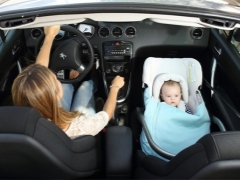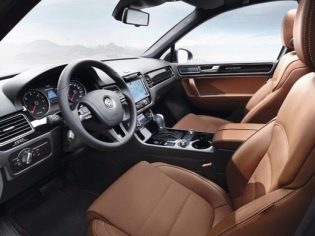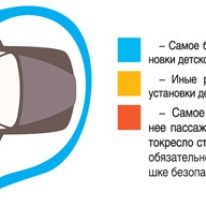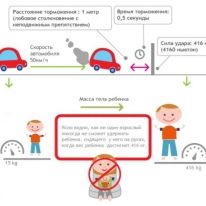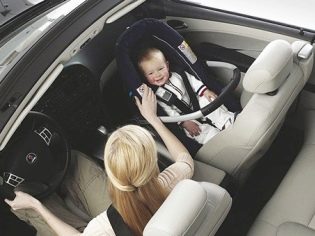Is it possible to carry a child in the car seat in the front seat?
Traditionally, most children's car seats are focused on the location behind, in some cases - even against the progress of the car. However, for parents, installing an accessory there is not always seems the most reasonable. To begin at least with the fact that sometimes the design of the car does not have much to install the purchased model of the car seat - although there is, of course, a question for parents who, for some reason, bought an inappropriate accessory.
In addition, children, being left behind alone, often capricious - they want to transfer to the front seat and see the opening landscapes, and to control their behavior, if only one of the parents is traveling with the child, it’s very problematic from the driver’s seat. In short, many parents would gladly transplant babies forward, however, some fear that such a decision is contrary to the law or elementary safety techniques. Let's try to figure out how things are in this area in fact.
Standards
When it comes to traveling by car, it should be remembered that almost all aspects of such movement are not determined at will, but strictly regulated by the rules of the road. Violation of any of the points in some individual cases can be understood from a human point of view, however, due to the fact that it has serious consequences, the offender may still be punished. The SDA includes not only the rules relating to the actual ride - the rules for the carriage of passengers in passenger cars are also registered there.
Here it should be clarified that the “children's” age, as understood by the legislator, ends at the age of 12, that is, after reaching the age of twelve, a small passenger can be transported on the same basis as an adult. If a child is 12 years old, he can ride in front even if there is no child car seat - it is enough for him to use standard car seat belts.
As for a child whose age is still less than 12 years old, he is not forbidden by the rules of the road to sit in front, but only on condition that a special restraint is used. Here, the legislator gives parents a certain freedom, since such means include not only the car seat itself, but also simpler models like boosters.
In this case, a special device should be specific, and not any. Paragraph 22.9 of the SDA indicates that a child under 12 years old is allowed to sit in the front seat only if the safety precautions are fully observed. At a minimum, the child car seat must necessarily correspond to the height and weight of the child, if the representative of the law sees a clear discrepancy between the parameters of the passenger and his seat, he may see it as an offense.
A completely separate point, which many parents do not even suspect, is the problem with the transportation of children in the front seat in the event that airbags are provided in the car.It is considered that to sit where such a pillow is, means to survive in a car accident, because the system will protect the passenger from a blow. In the case of a small child, everything can happen even the opposite, since the airbag opens very sharply and hits hard on everything that stands in its way.
If for an adult such a blow is unlikely to end with serious consequences, then for a child, whose body proportions are much smaller, and his bones are much thinner and weaker, he may be the cause of injury. At the same time, the airbag can unfold even in the event of a minor collision, from the consequences of which the child would be protected by the car seat itself, and then the ill-fated passenger protection system will not allow the baby to get rid of only with fear.
Pay special attention to the trauma of an airbag when parents want to transport a car carrier in the front seat. Because of its horizontal position, it occupies almost the entire space from the back of the front seat to the dashboard, so it takes up the blow at the earliest stages of the cushion opening. Given the fragility of the baby, which still has not overgrown the cradle, the consequences can be very dire.
For this reason, when installing the car seat in the front seat, the seat itself is recommended to be rolled back as far as possible to leave a kind of gap between the small passenger and the front panel of the cabin. Moreover, most experts give advice that seems somewhat illogical, but only at first glance - each time to disable the activation of the airbag for the place where it is planned to transport the child in the car seat.
Why it is not recommended to carry children in front?
The legislation of our country, like many others, in general does not prohibit the carriage of children in the car seat in the front seat, although it indicates that this requires a special child car seat with appropriate parameters. Nevertheless, even many adults believe that driving in the front seat is not as safe as in the back, so they can sit there themselves, but they will never put the child on board. It is possible to transport the baby in front, but it is probably worth listening to the arguments of those who consider this method of transportation to be unacceptable.
Reason # 1
Anyway, the front seats on average are protected from the effects of the accident is much weaker. Frontal collisions usually become the most powerful, and in fact in such a situation the front part of the car suffers the most. Installing a child car seat in the car in front significantly increases the chances of a child getting injured.
Expert groups from different countries specially collected statistics on the use of car seats of specific manufacturers and models when placed in front and rear, and obtained impressive results. Front trauma and even mortality on average about one and a half times higher with the same model.
Reason # 2
Installing a child car seat in the front passenger seat and not turning off the airbag before this is a very common mistake that causes child injuries almost more often than the consequences of the accident itself. The specifics of this problem have already been sufficiently discussed just above.
Reason number 3
Installing a child seat in the car in the front seat means providing unforgettable emotions to the child. Children sincerely rejoice at the possibility of driving in a car “like adults”, that is, in the front seat, and enjoying the view of the opening road, however, it does not always give positive emotions. Kids of preschool age, for example, are very emotional, and the sight of a huge cargo colossus rushing towards us, which in fact can safely travel in the oncoming lane, can frighten them.
Such a nervous shock does not allow the child to sleep and eat normally, and in some cases may even lead to hysteria. Imagine what the baby’s reaction would be if the cause of fright does not lie in his imagination, and the driver really barely escaped a collision. It is obvious that the worn out little passenger in the front seat does not contribute to lead better and more accurately.
Reason # 4
Many pediatricians say that the right car seat mounting for a child under 5 years old in a car should be strictly backwards, that is, against the car’s travel, which is almost impossible in the front seat. The fact is that at this age, the musculoskeletal system of the child’s body is still not fully formed, and therefore is not able to withstand serious loads.
If the child is turned face in the direction of travel, then even in case of sudden braking without an accident, a “nod” head forward is very likely, and the head at this stage of development is disproportionately large and heavy in relation to the rest of the body. The result is a critical load on the cervical spine, which can result in injury.
When a child goes backwards, as it were, such a "nod" will not work, since the head restraint will extinguish the blow and help the child to stand in the correct position. In the legislation of many European countries there is a ban on the transportation of such young children in any other position than the opposite direction of the car, and although we do not yet have such a norm, parents themselves can once again think about the health and safety of the baby.
Reason # 5
If you examine the recommendations of children's specialists regarding where the car seat should be located in the car, it turns out that it is best to place it in the middle of the rear seat. If the seats are arranged in three rows, then on average. It is there that the child will be equally protected both from frontal collisions and from side collisions.
From here we conclude that the location of the car seat in the front seat does not protect against one or the other - therefore, a significant proportion of the protection of the special equipment is leveled by its ill-conceived arrangement.
Security measures
Contrary to all the above, many parents still transport children in front. The reasons for this can be varied - for example, there is not enough space in the back in principle or because of too many transported things, one of the parents is carrying the child alone and wants to fully control the situation, or the kid is ready to give a tantrum if reasons he will be denied travel in the front seat.
The reason for transporting a child in front can be logically justified and understandable, however, this does not reduce the risk that arises in such a situation. In this vein, it is very important to give parents some simple tips that will help at least slightly reduce the risks that have appeared.
- Firstly, try to find even the slightest opportunity to install a chair from behind. If the chair is in front only because you could not carry the child from behind earlier, but now such an opportunity has appeared - use it immediately.
- To avoid future tantrums Immediately accustom the child to the fact that he can only drive in the front in very exceptional cases. Install a child seat in the back in all situations where this is possible.
- Having placed the child next to him, the parent-driver assumes that he will be able to pay more attention to the baby, however, the principle of reasoning here should be completely opposite. With such an arrangement, the child only needs a split second to assess his current state, but you should not be distracted from the road. Moreover, it is necessary to carefully analyze the traffic situation, trying to predict at what point it may change dramatically, so as not to be distracted at that moment.
- The airbag can be a true friend to the adult passenger and a sworn enemy for the baby. Before you install a child car seat in front, make sure the airbag is disabled.
- Regardless of whether the airbag is on, off or not at all, Try to move the seat with the car seat as far as possible from any parts of the body. In the event of a collision, the body may be crumpled and protruding sharp corners inside the cabin, and the child due to sudden braking can throw on them as much as the fixation belts will allow, because the greater the distance between them, the better.
- When transporting a child in the front seat, you should be prepared for the traffic police officers to try to penalize the driver. They may rely on ignorance of the rules for transporting small children, or simply put pressure on self-doubt, citing the fact that this type of child car seat is not a special vehicle for transporting children or that it does not fit a particular child in terms of parameters. If you are sure you are right, be ready to argue convincingly, including with the presentation of court decisions in similar situations.
- Carring a child in the front in the car seat is still allowed, although it is more dangerous than in the backseat, but transporting it in the front seat right on your hands is an unnecessary and very high risk. Any traffic police officer who stops such parents will have every right to register a violation of safety regulations, and in the event of a frontal collision, the result is most likely fatal for a child of negligent parents, because flying forward through the windshield is almost inevitable.
- Some modern carriages 2 in 1 and 3 in 1 suggest the removal of the cradle with its subsequent transformation into a car seat, however, this applies only to those models that are specially adapted for this purpose. Many parents, unknowingly or because of outrageous negligence, are trying to use the cradle of an ordinary classic stroller for the same purpose, which is completely unacceptable. The cradle must be able to be attached with special straps to the seatif there are no proper devices, then it does not guarantee the child’s safety at all, even in the case of simple sudden braking. Accordingly, it is not a special means, because the traffic police officer in this case can fix the violation.
Finally, you can give one more logical advice: use only the best car seats. Do not be lazy to search the Internet for video crash tests of all models, among which the intended purchase is selected, and to study how high the level of protection of a small passenger from a shock in the event of an accident.
Of course, it makes no sense to compare car seats for crash tests in the back seat, if you install the product you are going to the front.
Choosing the right car seat
The principles for choosing a child car seat for transporting a child in front are generally no different from similar principles for determining the best model for rear transportation. The only global difference is actually the ability to install the selected model from the front - where the dimensions of the free space and the presence or location of the mountings may differ. If you divide all the special tools into categories, then, depending on age and to avoid problems with the traffic police, you should choose the appropriate model of car seats.
- In the first year of his life, a childwhose weight does not reach 10 kilograms, is transported strictly in the autolink, being in a horizontal position.This design is least suitable for transportation in the front seat, because in some cases, if the cradle can not be installed behind, the baby is better to just leave at home.
- Up to one and a half years, passengers weighing less than 13 kilograms can be transported in a “cocoon” type child seat, which closely fits them on all sides, protecting them, including the head. Such a device must be installed against the direction of movement, because in the front seat it is usually installed only if it is possible to remove the backrest completely.
- At the age of one to four years and with a weight of 9 to 18 kilograms for the transportation of children, it is already possible to use chairs of universal design, which allows installation on any seats. From the point of view of safety, it is still better to transport the child in those models that are mounted backwards.
- For preschool children and children weighing 15-25 kilograms most often used car seats category 2, which are installed in the direction of motion. It is these chairs that are very often put on the front seats when transported by one parent, since passengers of this age really want attention to their person. Here, as nowhere else, it is crucial to disable the airbag, since such children often drive from the front and at the same time are still too fragile to withstand its impact.
- For school children younger than teenagers and weighing no more than 36 kilograms child car seats of group 3 are used. Often the standard seat belts of a car here are no longer fastened by the seat itself, but by the passenger sitting in it, which otherwise would have been fixed unreliably or incorrectly.
It should be understood that In the case of any car seat, not only the quality of the model in question is important, but also the correct installation. You can choose the best of its kind chair, which will show itself from the worst side in an accident due to the fact that it turned out to be fixed unreliable.
All experts recommend carefully choosing a car seat based on the results of reviews and video crash tests, but never go on a journey with him immediately after purchase.
First, parents are obliged to hone the procedure of installation and unfastening of the car seat to automatism in order to know that it is securely fastened and to be able to urgently release the child, if necessary.
On how to choose the right car seat for the child, see the following video from Dr. Komarovsky.
